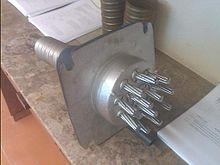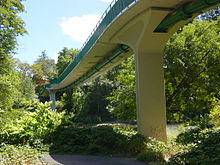- Prestressed concrete
-
Prestressed concrete is a method for overcoming concrete's natural weakness in tension. It can be used to produce beams, floors or bridges with a longer span than is practical with ordinary reinforced concrete. Prestressing tendons (generally of high tensile steel cable or rods) are used to provide a clamping load which produces a compressive stress that balances the tensile stress that the concrete compression member would otherwise experience due to a bending load. Traditional reinforced concrete is based on the use of steel reinforcement bars, rebars, inside poured concrete.
Prestressing can be accomplished in three ways: pre-tensioned concrete, and bonded or unbonded post-tensioned concrete.
Contents
Pre-tensioned concrete
Pre-tensioned concrete is cast around already tensioned tendons. This method produces a good bond between the tendon and concrete, which both protects the tendon from corrosion and allows for direct transfer of tension. The cured concrete adheres and bonds to the bars and when the tension is released it is transferred to the concrete as compression by static friction. However, it requires stout anchoring points between which the tendon is to be stretched and the tendons are usually in a straight line. Thus, most pretensioned concrete elements are prefabricated in a factory and must be transported to the construction site, which limits their size. Pre-tensioned elements may be balcony elements, lintels, floor slabs, beams or foundation piles. An innovative bridge construction method using pre-stressing is the stressed ribbon bridge design.
Bonded post-tensioned concrete
 Prestress post-tension anchor on display at Instituto Superior Técnico's civil engineering department
Prestress post-tension anchor on display at Instituto Superior Técnico's civil engineering department
Bonded post-tensioned concrete is the descriptive term for a method of applying compression after pouring concrete and the curing process (in situ). The concrete is cast around a plastic, steel or aluminium curved duct, to follow the area where otherwise tension would occur in the concrete element. A set of tendons are fished through the duct and the concrete is poured. Once the concrete has hardened, the tendons are tensioned by hydraulic jacks that react (push) against the concrete member itself. When the tendons have stretched sufficiently, according to the design specifications (see Hooke's law), they are wedged in position and maintain tension after the jacks are removed, transferring pressure to the concrete. The duct is then grouted to protect the tendons from corrosion. This method is commonly used to create monolithic slabs for house construction in locations where expansive soils (such as adobe clay) create problems for the typical perimeter foundation. All stresses from seasonal expansion and contraction of the underlying soil are taken into the entire tensioned slab, which supports the building without significant flexure. Post-tensioning is also used in the construction of various bridges, both after concrete is cured after support by falsework and by the assembly of prefabricated sections, as in the segmental bridge.The advantages of this system over unbonded post-tensioning are:
- Large reduction in traditional reinforcement requirements as tendons cannot destress in accidents.
- Tendons can be easily "woven" allowing a more efficient design approach.
- Higher ultimate strength due to bond generated between the strand and concrete.
- No long term issues with maintaining the integrity of the anchor/dead end.
Unbonded post-tensioned concrete
Unbonded post-tensioned concrete differs from bonded post-tensioning by providing each individual cable permanent freedom of movement relative to the concrete. To achieve this, each individual tendon is coated with a grease (generally lithium based) and covered by a plastic sheathing formed in an extrusion process. The transfer of tension to the concrete is achieved by the steel cable acting against steel anchors embedded in the perimeter of the slab. The main disadvantage over bonded post-tensioning is the fact that a cable can destress itself and burst out of the slab if damaged (such as during repair on the slab). The advantages of this system over bonded post-tensioning are:
- The ability to individually adjust cables based on poor field conditions (For example: shifting a group of 4 cables around an opening by placing 2 to either side).
- The procedure of post-stress grouting is eliminated.
- The ability to de-stress the tendons before attempting repair work.
Picture number one (below) shows rolls of post-tensioning (PT) cables with the holding end anchors displayed. The holding end anchors are fastened to rebar placed above and below the cable and buried in the concrete locking that end. Pictures numbered two, three and four shows a series of black pulling end anchors from the rear along the floor edge form. Rebar is placed above and below the cable both in front and behind the face of the pulling end anchor. The above and below placement of the rebar can be seen in picture number three and the placement of the rebar in front and behind can be seen in picture number four. The blue cable seen in picture number four is electrical conduit. Picture number five shows the plastic sheathing stripped from the ends of the post-tensioning cables before placement through the pulling end anchors. Picture number six shows the post-tensioning cables in place for concrete pouring. The plastic sheathing has been removed from the end of the cable and the cable has been pushed through the black pulling end anchor attached to the inside of the concrete floor side form. The greased cable can be seen protruding from the concrete floor side form. Pictures seven and eight show the post-tensioning cables protruding from the poured concrete floor. After the concrete floor has been poured and has set for about a week, the cable ends will be pulled with a hydraulic jack.
Applications
Prestressed concrete is the main material for floors in high-rise buildings and the entire containment vessels of nuclear reactors.
Unbonded post-tensioning tendons are commonly used in parking garages as barrier cable.[1] Also, due to its ability to be stressed and then de-stressed, it can be used to temporarily repair a damaged building by holding up a damaged wall or floor until permanent repairs can be made.
The advantages of prestressed concrete include crack control and lower construction costs; thinner slabs - especially important in high rise buildings in which floor thickness savings can translate into additional floors for the same (or lower) cost and fewer joints, since the distance that can be spanned by post-tensioned slabs exceeds that of reinforced constructions with the same thickness. Increasing span lengths increases the usable unencumbered floorspace in buildings; diminishing the number of joints leads to lower maintenance costs over the design life of a building, since joints are the major focus of weakness in concrete buildings.
The first prestressed concrete bridge in North America was the Walnut Lane Memorial Bridge in Philadelphia, Pennsylvania. It was completed and opened to traffic in 1951.[2] Prestressing can also be accomplished on circular concrete pipes used for water transmission. High tensile strength steel wire is helically-wrapped around the outside of the pipe under controlled tension and spacing which induces a circumferential compressive stress in the core concrete. This enables the pipe to handle high internal pressures and the effects of external earth and traffic loads.
Design agencies and regulations
In the United States, pre-stressed concrete design and construction is aided by organizations such as Post-Tensioning Institute (PTI) and Precast/Prestressed Concrete Institute (PCI). In Canada the Canadian Precast/prestressed concrete Institute assumes this role for both post-tensioned and pre-tensioned concrete structures.
Europe also has its own associations and institutes. It is important to note that these organizations are not the authorities of building codes or standards, but rather exist to promote the understanding and development of pre-stressed design, codes and best practices. In the UK, the Post-Tensioning Association fulfills this role.[3]
See also
- Prestressed structure
- Reinforced cement concrete
- Hollow-core slab
- Eugène Freyssinet
References
Categories:- Concrete
- Building materials
- Structural engineering
Wikimedia Foundation. 2010.












